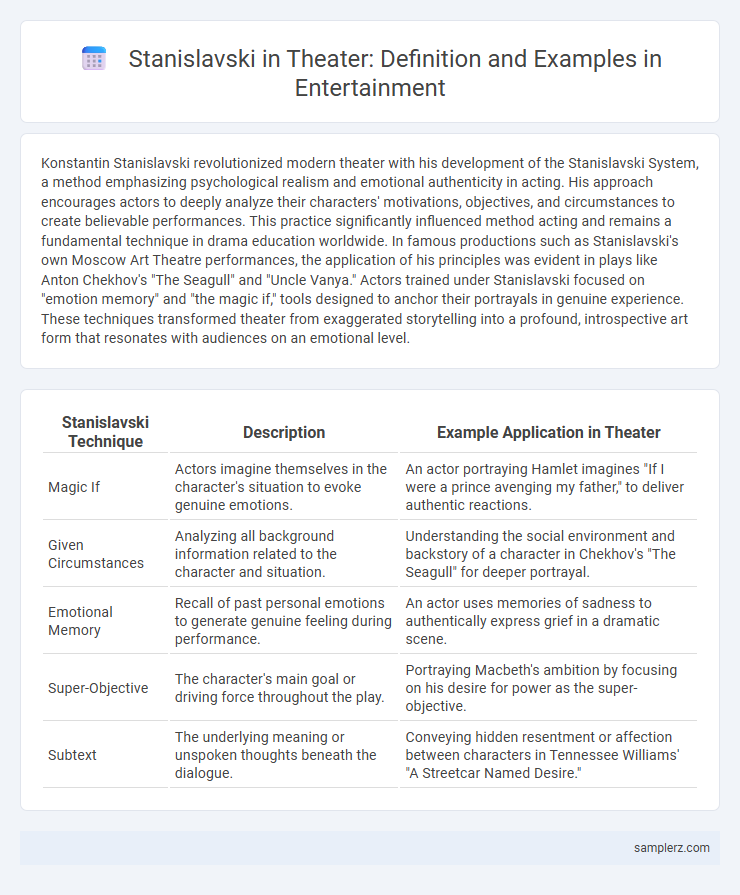Konstantin Stanislavski revolutionized modern theater with his development of the Stanislavski System, a method emphasizing psychological realism and emotional authenticity in acting. His approach encourages actors to deeply analyze their characters' motivations, objectives, and circumstances to create believable performances. This practice significantly influenced method acting and remains a fundamental technique in drama education worldwide. In famous productions such as Stanislavski's own Moscow Art Theatre performances, the application of his principles was evident in plays like Anton Chekhov's "The Seagull" and "Uncle Vanya." Actors trained under Stanislavski focused on "emotion memory" and "the magic if," tools designed to anchor their portrayals in genuine experience. These techniques transformed theater from exaggerated storytelling into a profound, introspective art form that resonates with audiences on an emotional level.
Table of Comparison
| Stanislavski Technique | Description | Example Application in Theater |
|---|---|---|
| Magic If | Actors imagine themselves in the character's situation to evoke genuine emotions. | An actor portraying Hamlet imagines "If I were a prince avenging my father," to deliver authentic reactions. |
| Given Circumstances | Analyzing all background information related to the character and situation. | Understanding the social environment and backstory of a character in Chekhov's "The Seagull" for deeper portrayal. |
| Emotional Memory | Recall of past personal emotions to generate genuine feeling during performance. | An actor uses memories of sadness to authentically express grief in a dramatic scene. |
| Super-Objective | The character's main goal or driving force throughout the play. | Portraying Macbeth's ambition by focusing on his desire for power as the super-objective. |
| Subtext | The underlying meaning or unspoken thoughts beneath the dialogue. | Conveying hidden resentment or affection between characters in Tennessee Williams' "A Streetcar Named Desire." |
Understanding Stanislavski: The Foundation of Modern Acting
Stanislavski's system revolutionized theater by emphasizing emotional truth and psychological realism, forming the foundation of modern acting techniques. His method involves actors deeply analyzing their characters' motivations and circumstances, promoting genuine, believable performances. This approach remains crucial for actors aiming to connect authentically with their roles and audiences.
Stanislavski’s Influence on Contemporary Theatre Productions
Stanislavski's system revolutionized contemporary theatre by introducing naturalistic acting techniques that emphasize emotional truth and character motivation. His methods, such as the "magic if" and emotional memory, are foundational in actor training across modern productions worldwide. Contemporary directors and actors continue to adapt his principles to create more authentic and psychologically complex performances.
Key Techniques from Stanislavski Method in Stage Performances
Stanislavski's method in theater emphasizes emotional memory, physical actions, and the "magic if" to create authentic performances. Actors use affective memory to recall personal experiences that resonate with their character's emotions, enhancing believability on stage. Concentration and ensemble awareness foster deep stage presence, making the portrayal immersive and compelling.
Character Development: Applying Stanislavski’s System
Stanislavski's system emphasizes deep character development through methods like emotional memory and the "magic if," which encourage actors to authentically inhabit their roles by connecting personal experiences with the character's motivations and circumstances. This technique transforms performances by fostering genuine emotional responses and nuanced behaviors that resonate with audiences. Many modern actors integrate Stanislavski's principles to create complex, believable characters that enhance theatrical storytelling.
Emotional Memory Exercises in Stanislavski’s Approach
Stanislavski's Emotional Memory exercises require actors to draw upon their personal past experiences to evoke genuine emotions on stage, enhancing character authenticity. This technique enables performers to connect deeply with their roles by recalling specific sensory details and feelings, thereby producing more truthful and compelling portrayals. Emotional Memory remains a cornerstone of Stanislavski's system, significantly influencing modern method acting practices.
Notable Stage Productions Exemplifying Stanislavski’s Method
Stanislavski's method revolutionized theater with notable stage productions like Anton Chekhov's "The Seagull" and "Uncle Vanya," where actors embodied authentic emotional truth through psychological realism. The Moscow Art Theatre's groundbreaking interpretations showcased precise emotional recall and subtext analysis, emphasizing the actor's inner experience. These performances set enduring standards for naturalistic acting that continue to influence modern theater productions worldwide.
Iconic Actors Who Utilized Stanislavski’s Techniques
Marlon Brando revolutionized American theater and film by applying Stanislavski's method of emotional truth and deep character analysis, profoundly influencing acting techniques in the 20th century. Laurence Olivier exemplified the Stanislavski system through his meticulous character preparation and psychological realism in Shakespearean roles. Al Pacino's intense character immersion and spontaneous emotional expression directly reflect Stanislavski's principles, solidifying his status as a master of method acting.
The Role of Truth and Realism in Stanislavski-Based Acting
Stanislavski revolutionized theater by emphasizing truth and realism in acting, encouraging performers to embody genuine emotions and motivations. His system teaches actors to create believable characters through detailed psychological preparation and authentic emotional experiences. This approach has profoundly influenced modern theater, inspiring actors to deliver compelling and truthful performances on stage.
Transforming Scripts: Directors Using Stanislavski’s Principles
Directors applying Stanislavski's principles transform scripts by emphasizing realistic character development and emotional truth, fostering immersive performances. His techniques guide actors to delve deeply into motives and psychological nuances, reshaping traditional narratives into authentic theatrical experiences. This method enhances audience engagement by creating believable, emotionally resonant characters on stage.
Legacy of Stanislavski in Today’s Theatrical Landscape
Stanislavski's system revolutionized modern acting by introducing techniques such as emotional memory and the "magic if," which remain integral to contemporary theater training. His emphasis on psychological realism and actor authenticity directly influences methods like Method Acting and Meisner Technique, shaping performers' approach to character development. The legacy of Stanislavski endures in today's theatrical landscape through continuous application in drama schools, professional theaters, and actor workshops worldwide.

example of Stanislavski in theater Infographic
 samplerz.com
samplerz.com